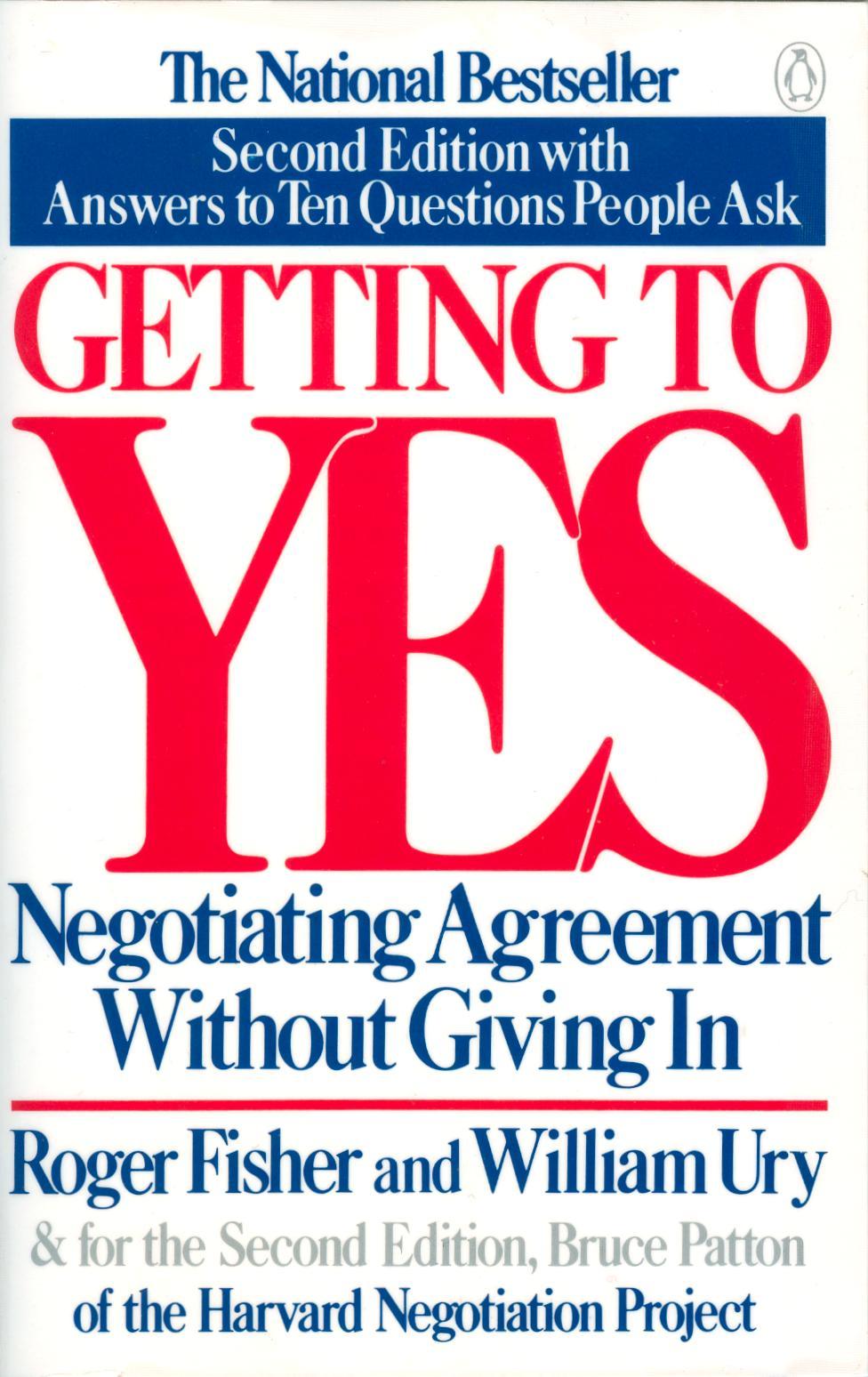Getting to Yes (book review & summary)

A revised edition of this landmark book from the early-eighties. Arguably still a worthwhile introductory read for today's novice negotiator. Our summary and book review follows.
Level: Beginners
Categories: Academics and Historians
Publication Date: 2006-11-28
Getting to Yes – Negotiating Agreement Without Giving In by Roger Fisher and William Ury was first published in 1981. The title has become a classic read for any novice interested in learning negotiation skills.
While the book is still a very useful read, the reader should be aware that negotiation theory has not remained static. Many negotiation writers have challenged some aspects of Fisher and Ury’s model and approach, as negotiation itself has evolved due to rapid changes in business.
The four-point steps which define the Fisher and Ury method offer a novel and fresh approach to conducting negotiations in our fast-paced and ever-changing business climate. Their methodology opposes the fixed-pie mentality that still predominates much of our negotiating culture.
The problem at a glance reveals how we all too often become embroiled in an unnecessary and embittered tussle over entrenched positions. Many deals have collapsed because the participants could not see the forest for the trees. In other words, the participants failed to see the bigger picture. The participants focused too much on winning instead of making a mutually profitable deal.
The authors were also the first to coin the acronym BATNA, which stands for “best alternative to a negotiated agreement.” This term essentially describes the need to conceive of creating and developing back-up plans when all else fails. Invariably, not even our best intentions to find agreement will necessarily come to fruition.
Getting to Yes remains the single most popularly read negotiation book when we poll our clients entering our sales negotiation training and procurement negotiation training courses.
The Method in a Nutshell
The first two stages outlined by the authors encourage us to separate the people from the problem. This is achieved by focusing on interests and not on our mutual positions. We are then encouraged to invent options for mutual gain. Finally, we must insist on using objective criteria in being realistic in establishing standards.
Here’s the process outlined in more detail:
1. Separate the People from the Problem
We cant deal with a problem when people misunderstand each other and emotions run rampant. As business people or leaders, we probably like to view ourselves as logical and levelheaded when it comes to solving knotty issues, disputes, and problem-solving. However, we are all influenced by our upbringing, culture, and simply by being emotional humans.
We all perceive our world differently. As such, we often take different, if not opposing, viewpoints when handling a problem or dispute with another person. In so doing, we often give little or any regard to the other person’s perspective. This is a narrow approach to problem-solving and is often a recipe for conflict and disaster.
Fisher and Ury suggest that every person involved in negotiation or dispute resolution has two separate kinds of interests. The first is the substantive, which entails our own respective interests. The second interest entails the interpersonal relationship between the two negotiating sides. The main problem occurs when the relationship becomes entwined with the problem being addressed. In positional negotiation, the problem becomes personal as the two separate interests become emotionally enmeshed with each other.
The people problem is seen as stemming from one or more of three basic categories, being:
- Perception
- Emotion
- Communication
By stepping back and analyzing the problem area where we have become sidetracked, we can address the conflict from a more realistic perspective. We can also establish a clearer understanding of the positions of both sides. We accomplish this feat by focusing on the underlying interests instead of the emotional burrs causing the irritation in our interaction.
2. Focus on Interests, Not Positions
The issue here can be summed up by saying that we tend to become fixated on our respective positions. We attempt to find agreement on a particular position, which rarely works. The positions often directly result in conflict between each other’s emotional basis, which forms the foundation for our respective positions.
Rather, what we need to understand and determine are the real interests forming the basis of the positions of both sides. These fundamental issues are our real interests that can be both conflicting and compatible. The question we usually ask is What do you want? The more important question that we fail to ask instead is Why do you want this?
There is a purpose behind every position. Without knowing the real motivating purpose or reason, it then becomes almost impossible to identify or appreciate the problem that actually needs to be addressed.
Fisher and Ury realized that our most powerful interests relate to basic fundamental human needs. These needs include our:
- Security
- Economic well-being
- Sense of belonging
- Recognition
- and control over one’s life
The authors point out that these fundamental needs do not just relate to individuals. Instead, these needs should also be extended to any group involved in the negotiation process. These groups could be corporate entities, organizations, or even nations.
We have to acknowledge not only our interests but, perhaps even more importantly, the other side’s interests as well. Through active and involved dialog and communication, both sides can gain a better understanding of each other’s interests. Only when we have properly identified the full scope of the problem can, or indeed should, we even begin to look at solutions.
Mutual Options for Mutual Gain
Fisher and Ury point out that even though people succeed in diagnosing the problem, there’s still a tendency to take the view that our answer alone is the correct response. It is not a natural tendency to be creative in developing alternatives to effectively solve the dispute. The authors state that there are four obstacles that we must first overcome:
- Premature judgment
- Searching for the single answer
- The assumption of the fixed pie
- Thinking that solving their problem is their problem
Fisher and Ury suggest that we should first invent our options. We should then decide on the best mutual course of action after both sides have brainstormed the problem together. We can multiply options by moving between specific aspects of the individual issues and the overall problem itself. Most disputes generally tend to have multiple components that can be addressed by:
- Defining the problem
- Analyzing the causes into categories
- Considering possible strategies and using broad thinking to solve the issues
- and by looking at what specific steps could be taken
The purpose of the above exercise should be to take an approach of mutual gain by establishing your shared interests. For example, one common shared interest might be the future of our relationship with the other side. The authors maintain that it is possible to find agreement through disagreement. This is by suggesting several options that are acceptable to us and asking the other side to respond in kind. The key to convincing the other side to agree is to make the other side’s decision an easy one to make.
Insist on Using Objective Criteria
In the final phase, Fisher and Ury again stress that we must avoid the pitfall of getting into a battle of wills. Instead, the authors say that we should negotiate on the basis of using objective criteria. Objective criteria could be:
- Market value
- Replacement cost
- Industry standards
- Precedent
- Reciprocity
- Effectiveness
- or any applicable principle which is a true reflection of what is fair and reasonable.
Remember, don’t be shy about seeking out the advice of experts.
The authors say there are three basic points to remember:
- Frame each issue as a mutual search for objective criteria.
- Be both reasonable and open to reason as to which standards should be used and how they should be applied.
- Never bend to pressure, only to principle.
Even before considering the terms to an agreement, it is often better to first agree on the particular objective criteria or standards that should be applied. Simply put, if we use the criteria that the other side proposed, we now can use it as a lever to persuade the other side more effectively.
Regardless of how effectively we might try to implement these four-step principles, the other side may not be open to being reasonable. In that case, we have to weigh up our options. We have to decide whether we will accept their position or walk away and resort to our best alternative. Finally, don’t let yourself be bogged down solely by company policy or procedure. There’s an exception to most rules, and almost everything is negotiable.
Conclusion
We all want to negotiate the best possible deal. However, we have to remember there is often more at stake than our personal interests and egos. We can solve more problems if we understand the underlying interests. In addition, we can create durable relationships if we don’t let ourselves work at cross purposes in finding mutually creative and beneficial solutions.
YOU MAY ALSO LIKE







